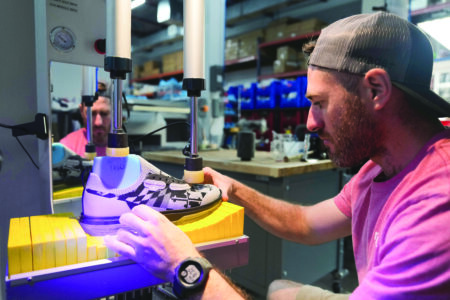More than one way to do math
NMU awarded Mi-STEM Advisory Council grant

Northern Michigan University has received an MiSTEM Advisory Council grant of nearly $300,000 to incorporate the Add+Vantage Math Recovery program for Upper Peninsula elementary schools. It also will provide related teacher training. (Journal photo by Christie Bleck)
MARQUETTE — Figuring out math problems, even simple ones, can test the confidence of both teacher and pupil.
A newly awarded grant might help change that.
Northern Michigan University has been awarded a nearly $300,000 MiSTEM Advisory Council grant for one year that will incorporate the Add+Vantage Math Recovery program for Upper Peninsula elementary schools and provide related teacher training.
Chris Standerford, based at the Glenn T. Seaborg Math and Science Center on the NMU campus, directs the central region that covers Marquette, Alger, Delta, Menominee, Schoolcraft, Dickinson and Iron counties.
Elementary students are the focus of the project that revolves around the STEM subjects of science, technology, engineering and mathematics.
“Sometimes we talk about getting students engaged in STEM and those efforts often are at the high school level because we’re thinking about career pathways and post-secondary things that they might want to go study, either at a university or a community college or whatever,” Standerford said.
This grant hones in on grade school kids.
“Our take on this one was if we target those younger students and help them build some confidence in the STEM subjects, it will open up STEM subjects that they wouldn’t see as options otherwise.
“Again, you’re opening the door to kind of a gateway for a whole new batch of students. You’re not just targeting students that are already interested in STEM at the high school level, but you’re trying to open up that door for more students to have that interest.”
He acknowledged if this STEM interest isn’t sparked early, it could be lost later on during their educational years.
A lot of people might be turned off by math, whether it’s algebra, geometry or even just “simple” long division.
Perhaps it doesn’t have to be that way.
“They’re intimidated by it, and so they think, ‘Oh, you know, like drafting, that’s too technical. There’s fractions. I’m not good at fractions. I’m not going to do that,'” Standerford said.
So, they shut down fields such as engineering and architecture, he said.
“Really, it’s just a math thing where they have the ability,” Standerford said. “We’re pretty sure they will. They just need a few tools. They just need some confidence that those are options for them too.”
He said the math project will involve six facilitation sites, with teachers training close to their schools. A workshop will be offered in two parts, each spanning four days.
Also, not only are the workshops free, the grant will cover substitute teacher costs and summer stipends, plus teachers will receive math kits, he said.
The MiSTEM Advisory Council was created by the Michigan Legislature in 2015 to recommend high-quality programs for funding and create a vision for a statewide STEM strategy. It identified four pillars needed for a well-equipped foundation for a statewide STEM educational network: creating a STEM culture, empowering STEM teachers, integrating business and education, and ensuring high-quality STEM experiences.
Renee Jewett, a STEM education consultant at NMU who’s also based at the Seaborg Center, said main topic areas involved in the program include “number words and numerals” — recognizing the digit in a word and its value — at the kindergarten level.
Of course, there will be addition, subtraction, multiplication and division.
There also will be place value and structuring numbers, said Jewett, who pointed out students tend to struggle with the latter topic.
She called that “how to make numbers work for you,” which delves into why students figure out certain math problems.
“They know how to use standard algorithm,” Jewett said. “They know how to go through the steps, the tricks.”
However, they don’t have an understanding behind that or why they’re doing those steps or tricks, she said.
Jewett used making a 10 as an example.
“If I’m comfortable with my doubles, I can know that 5 and 5 is 10,” Jewett said, “but if I’m not comfortable with my double stacks, I can know that I can do, ‘OK, it’s 5 and 4 and 1 more to make 10.'”
That strategy could work for many youngsters.
“It makes the math accessible for every student, but it’s often something that teachers have a hard time teaching,” she said.
Jewett said the problem lies in the way teachers were educated — that there just was one method.
Now there are many strategies they can use.
However, teachers need to believe they can teach them.
“I think the confidence level just isn’t there for teachers,” Jewett said.
Fear of math even might not be limited to teachers.
Jewett, though, believes everyone is a math person.
“Our brains are made to understand math,” she said. “They’re wired that way for a reason. We just don’t understand it all the time because we might not have been taught in a way that works for us.”
Standerford pointed to all the puzzles out there, such as Sudoku, that use problem-solving techniques, and finding patterns and relationships.
“People love puzzles, and sometimes they don’t recognize they love it,” he said.
The Add+Vantage Math Recovery program, Jewett said, shows teachers how to differentiate math education for various tiers of students.
Standerford agreed that multiple ways of learning is a good thing.
“It’s just harder to anticipate as a teacher when you’re working with 30 students, maybe harder to accommodate, because there’s a couple of ways to kind of get to it efficiently, but those couple of ways may not hit the needs of all the learners,” he said.
Again, confidence is crucial.
“If they’re passionate about it and confident, it’s going to come off in their teaching and students will benefit,” Jewett said.





